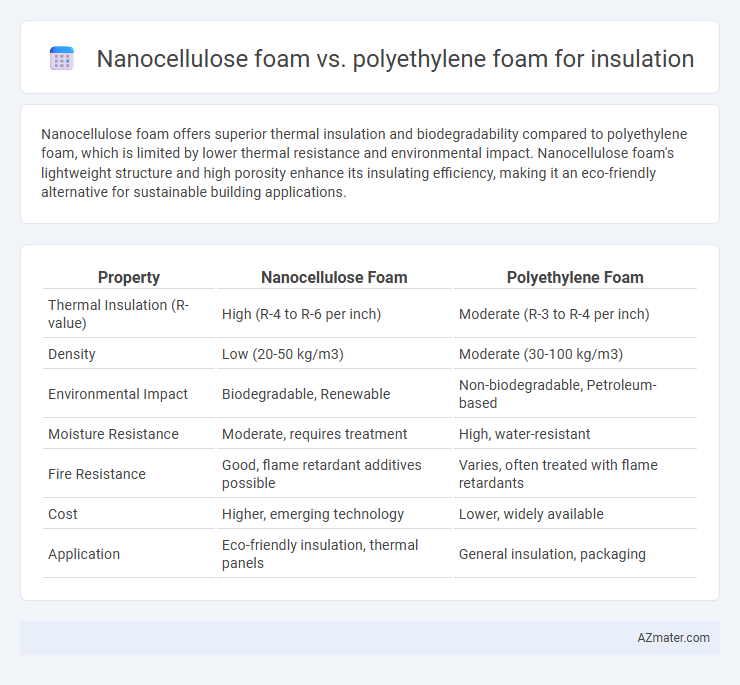Nanocellulose foam offers superior thermal insulation and biodegradability compared to polyethylene foam, which is limited by lower thermal resistance and environmental impact. Nanocellulose foam's lightweight structure and high porosity enhance its insulating efficiency, making it an eco-friendly alternative for sustainable building applications.
Table of Comparison
| Property | Nanocellulose Foam | Polyethylene Foam |
|---|---|---|
| Thermal Insulation (R-value) | High (R-4 to R-6 per inch) | Moderate (R-3 to R-4 per inch) |
| Density | Low (20-50 kg/m3) | Moderate (30-100 kg/m3) |
| Environmental Impact | Biodegradable, Renewable | Non-biodegradable, Petroleum-based |
| Moisture Resistance | Moderate, requires treatment | High, water-resistant |
| Fire Resistance | Good, flame retardant additives possible | Varies, often treated with flame retardants |
| Cost | Higher, emerging technology | Lower, widely available |
| Application | Eco-friendly insulation, thermal panels | General insulation, packaging |
Introduction to Insulation Materials
Nanocellulose foam and polyethylene foam are widely used insulation materials with distinct properties. Nanocellulose foam offers excellent thermal insulation, biodegradability, and high mechanical strength due to its nanoscale cellulose fibers. Polyethylene foam provides lightweight, moisture resistance, and flexibility, making it suitable for various thermal and acoustic insulation applications.
Understanding Nanocellulose Foam
Nanocellulose foam, derived from cellulose nanofibers, offers superior thermal insulation properties compared to traditional polyethylene foam due to its high porosity and low thermal conductivity. This biodegradable material also provides enhanced mechanical strength and moisture resistance, making it ideal for sustainable building applications. Nanocellulose foam's lightweight structure and renewable source contribute to its growing popularity in environmentally friendly insulation solutions.
Overview of Polyethylene Foam
Polyethylene foam is a lightweight, closed-cell material known for its excellent thermal insulation properties and high resistance to moisture, making it widely used in construction and packaging industries. Its cellular structure provides effective cushioning and sound absorption, while being chemically inert and resistant to many solvents, acids, and bases. Despite its durability and cost-effectiveness, polyethylene foam has a higher environmental impact compared to biodegradable alternatives like nanocellulose foam.
Key Properties Comparison: Nanocellulose vs Polyethylene
Nanocellulose foam demonstrates superior thermal insulation with a low thermal conductivity of approximately 0.03 W/m*K, compared to polyethylene foam's typical range of 0.035-0.04 W/m*K, enhancing energy efficiency in building applications. The biodegradability and renewable nature of nanocellulose significantly reduce environmental impact, whereas polyethylene foam is derived from non-renewable petroleum and exhibits limited recyclability. Additionally, nanocellulose foam offers higher mechanical strength and better moisture resistance, making it a more durable and sustainable option for insulation compared to conventional polyethylene foam.
Thermal Insulation Performance Analysis
Nanocellulose foam exhibits superior thermal insulation performance compared to polyethylene foam due to its lower thermal conductivity, typically around 0.03 W/m*K versus polyethylene's range of 0.035-0.04 W/m*K. The high porosity and nanoscale fibril network in nanocellulose foam reduce heat transfer by trapping more air, enhancing its insulation efficiency. Polyethylene foam, while lightweight and moisture-resistant, often shows higher thermal bridging and reduced effectiveness in extreme temperature fluctuations.
Environmental Impact and Sustainability
Nanocellulose foam offers superior environmental benefits compared to polyethylene foam due to its biodegradability and renewable origin from cellulose fibers. It generates significantly lower carbon emissions during production and decomposes naturally, reducing landfill waste and microplastic pollution. Polyethylene foam, derived from petroleum, poses sustainability challenges with its lengthy degradation time and reliance on non-renewable fossil fuels, contributing to environmental pollution and resource depletion.
Fire Resistance and Safety Considerations
Nanocellulose foam exhibits superior fire resistance compared to polyethylene foam due to its natural char-forming properties and lower flammability, enhancing safety in insulation applications. Polyethylene foam tends to ignite easily and produces toxic fumes when burned, raising concerns in fire safety. Selecting nanocellulose foam can significantly reduce fire hazards and improve overall building safety standards.
Mechanical Strength and Durability
Nanocellulose foam exhibits superior mechanical strength due to its high tensile modulus and excellent stress distribution properties, outperforming polyethylene foam in load-bearing applications. The inherent biodegradability and nanofibril network of nanocellulose enhance its durability under cyclic compression and environmental stress compared to the more prone-to-deformation polyethylene foam. Nanocellulose foam maintains structural integrity and resists mechanical fatigue longer in insulation settings, making it a sustainable and robust alternative for long-term performance.
Cost and Availability in the Market
Nanocellulose foam, derived from renewable cellulose fibers, is generally more expensive than polyethylene foam due to its advanced production process and limited large-scale manufacturing. Polyethylene foam benefits from widespread availability and established supply chains, making it cost-effective and easily accessible for insulation purposes. Despite higher initial costs, nanocellulose foam offers potential long-term savings through superior thermal performance and sustainability.
Applications and Future Prospects
Nanocellulose foam, derived from renewable cellulose fibers, offers superior thermal insulation, biodegradability, and mechanical strength compared to polyethylene foam, making it ideal for sustainable building insulation and aerospace applications. Polyethylene foam remains widely used due to its cost-effectiveness, moisture resistance, and impact absorption in packaging, automotive, and construction sectors. Emerging research on nanocellulose foam highlights its potential to replace synthetic foams by improving fire resistance, reducing environmental impact, and enabling advanced thermal management in electronic devices and green infrastructure.

Infographic: Nanocellulose foam vs Polyethylene foam for Insulation
 azmater.com
azmater.com